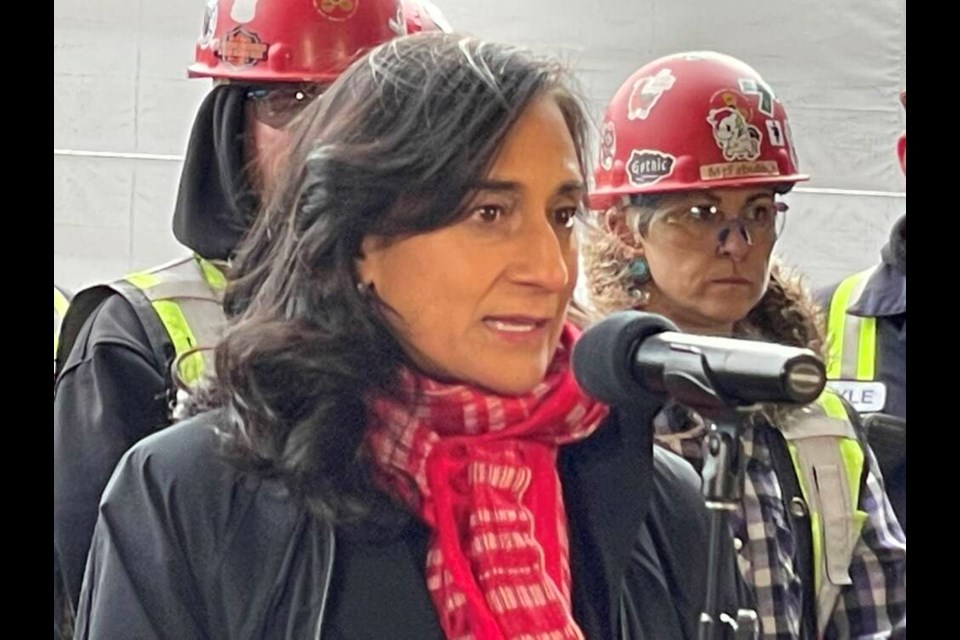Canada’s Defence Minister Anita Anand said Wednesday the discovery of apparent spy buoys in Canada’s Arctic and the shooting down of a possible spy balloon over the Yukon highlight the need to protect the country’s sovereignty in the North.
“We have to make sure that we continue to do what is necessary to protect our Arctic, to maintain our Arctic sovereignty,” said Anand.
Anand added she’s been meeting with fellow Arctic defence ministers – with the notable exception of Russia – about how to guard against threats to Arctic sovereignty as well as how to address climate change that is impacting the North.
Anand made her comments after a recent report in the Globe and Mail indicated the Canadian military discovered and retrieved Chinese “monitoring buoys” in the Arctic this fall.
In a statement provided to the North Shore News, the Department of National Defence said it is aware of "recent efforts by China to conduct surveillance operations in Canadian airspace and maritime approaches utilizing dual purpose technologies."
According to statement , the monitoring buoys were spotted by the military as part of Operation Limpid, which focuses on early detection of threats to Canada’s security. The defence department added "since 2022, it has stopped attempts to surveil Canadian territory."
Spy buoys in Arctic 'not new'
Anand confirmed Wednesday Canada is “fully aware of the buoys, and, as mentioned, extracted those buoys.”
“We are also aware that this type of activity is not new.”
Anand didn’t elaborate on the discovery of the spy buoys, but said their presence and the recent shooting down of a possible spy balloon over the Yukon highlights the need to keep working with the U.S. on upgrading continental defence.
Canada is investing almost $40 billion in NORAD modernization and continental defence, Anand said, which will include a new “Northern approaches surveillance system” which will replace the existing NORAD early warning system.
“We are going to put in place an over-the-horizon radar system which is able to detect threats further and further North,” said Anand.
Search called off for balloon downed over Yukon
Anand provided few details on whether any search will be resumed by Canada for the debris of the mysterious balloon that was shot down by the U.S. under NORAD command at about 40,000 feet over central Yukon Feb. 11.
The balloon was shot down to “ensure the protection of Canadians and Canadian airspace,” said Anand.
Afterwards, the RCMP, Canadian Armed Forces and FBI Special Forces were all called in to recover the debris, but “the terrain is very rugged, very remote and temperatures are very cold. It was snowing very heavily,” said Anand. That resulted in the recent decision to call off the search.
Anand said because the debris hasn’t been recovered, it’s impossible to know for sure if the balloon was a spy balloon, a research balloon or something totally unrelated.
U.S. President Joe Biden said recently while the balloon recovered off the South Carolina coast is believed to be a Chinese monitoring balloon, there’s nothing to suggest the other balloons are part of any spying operation by other countries.
On Wednesday, Canada’s defence minister added Canadian forces are continuing to work with American counterparts on sharing any information recovered from the first of the four high-altitude balloons shot down by the U.S. off the East Coast after the balloon drifted the length of British Columbia before crossing into the U.S. and across that country.
Spy balloon drifted length of СŔ¶ĘÓƵ
Anand didn’t directly address a question of why the public wasn’t notified of the balloon as it drifted over British Columbia or whether it was considered a threat, but commented, “The surveillance that NORAD undertakes is 24 hours a day, seven days a week. They leave no stone unturned in terms of detecting any threats or potential threats in Canadian airspace.”
Anand made her comments about Canada’s need to protect Canadian sovereignty and during a stop at Seaspan Shipyards in North Vancouver, where two massive joint support ships for the Canadian Navy are currently under construction, along with an oceanographic science ship for the Coast Guard.
The shipyard is also slated to produce one of two polar icebreakers needed by the federal government by 2030. The other icebreaker is to be built in a Quebec shipyard.



